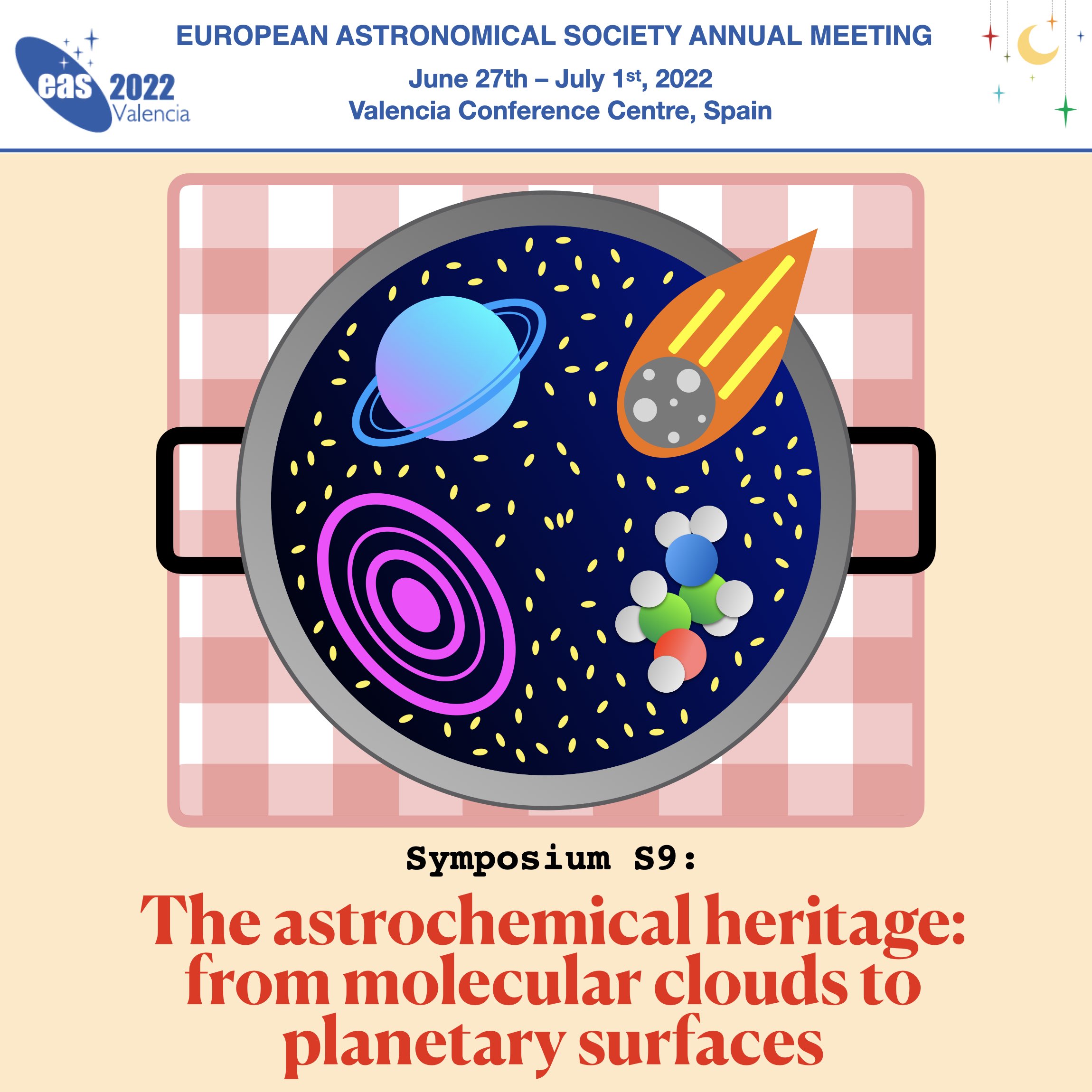Symposium S9
30 June - 1 July 2022
The astrochemical heritage: from molecular clouds to planetary surfaces

Aims and scope
The question of the origin of Life has intrigued human beings for centuries. We still do not understand how simple molecules combine together to form large molecules essential for living organisms. Recent prebiotic experiments have suggested that the three basic macromolecular systems (nucleic acids, proteins and lipids) could have formed from relatively simple precursors. The detection of some of these molecules in the interstellar medium (ISM), thanks to the unprecedented capabilities of current astronomical facilities, has opened a new window for astrobiology from the astronomical point of view. Life is expected to emerge on planets, which are formed at the same time as their host stars. Stars like our Sun form in dense
star clusters, which in turn are formed by the gravitational collapse of large molecular clouds. Therefore, a deep understanding of the chemical reservoir of the different phases of star formation, including molecular clouds, star-forming regions, protoplanetary disks, protosolar nebula analogs and Solar System bodies (planets, meteorites and comets), is crucial to understand how Life could have appeared starting from simple molecular precursors.
Among the more than 255 molecules detected in the ISM so far, about 50 have been identified in the last 3 years. This impressive explosion in the detection rate is due to the improved sensitivity of the instrumentation of different facilities such as the single-dish IRAM 30m, GBT 100m, and Yebes 40m telescopes, and the interferometer ALMA. Furthermore, the European Space Agency spacecraft Rosetta, which visited in situ the comet 67P/Churyumov-Gerasimenko, has provided an unprecedented view of its amazingly-rich chemical content. Moreover, the launch of the James Webb Space telescope (JWST) in December 2021 will offer a unique opportunity to study for the first time the chemical composition of the ices of interstellar dust grains, which will nicely complement our current understanding of the gas-phase reservoir. In the field of planetary science, the instrumentation on-board current space missions (e.g. Perseverance in Mars) and future devices will be able to detect the presence of organics on the surface of our neighbouring planets in the Solar System.
In order to interpret the plethora of information that current and future ground-base telescopes and space missions will provide, the community is putting extraordinary effort into understanding how this rich variety of molecules is formed in these different environments. Spectroscopic works in the laboratory are essential to determine accurately the microwave spectrum of molecules, enabling their interstellar detection. Laboratory experiments mimicking the conditions of the ISM, combined with quantum chemical calculations using high-performance computing facilities and machine learning techniques, are giving us key insights about how molecules (especially the most complex ones) can be formed in space.
This EAS Symposium aims to bring this multidisciplinary community together to share ideas, discuss about recent outstanding results, identify the key limitations in our current understanding of the chemical complexity in the ISM and the Solar System, and to foster new ways to overcome those limitations. With ALMA and single-dish radiotelescopes delivering continuously new results, with the comprehensive picture of the chemical composition of a comet recently provided by Rosetta, with Perseverance studying the Mars surface, and the launch of JWST, this symposium arrives at the right moment to draw a complete and detailed view of our knowledge of the chemical heritage of star and planet formation, and to design the strategy to best exploit these and future facilities in the coming decades.
Programme
- SESSION 1: Chemical complexity in molecular clouds and massive star-forming regions
- SESSION 2: Chemical complexity in prestellar cores, Solar-like star-forming regions, protoplanetary disks and comets
- SESSION 3: Laboratory experiments
- SESSION 4: Quantum chemical calculations, chemical models and machine learning techniques
- SESSION 5: Organics in meteorites and planetary environments
Invited speakers
- Rosario Brunetto (Université Paris-Saclay, France)
- José Cernicharo (Instituto de Física Fundamental, CSIC, Spain)
- Maria Drozdovskaya (Universität Bern, Center for Space and Habitability, Switzerland)
- Jon Holdship (Leiden University, The Netherlands)
- John Ilee (University of Leeds, United Kingdom)
- Sergio Ioppolo (Queen Mary University of London, United Kingdom)
- Thanja Lamberts (Leiden University, The Netherlands)
- Niels Ligterink (Universität Bern, Center for Space and Habitability, Switzerland)
- Zita Martins (Instituto Superior Técnico, Portugal)
- Melissa McClure (Leiden University, The Netherlands)
- Mattia Melosso (University of Bologna, Italy)
Scientific organisers
- Víctor M. Rivilla (Chair) (Centro de Astrobiología, CSIC-INTA, Spain)
- Arnaud Belloche (Max-Planck Institute for Radio Astronomy, Germany)
- Paola Caselli (Max-Planck Institute for Extraterrestrial Physics, Germany)
- Cristina Puzzarini (University of Bologna, Italy)
- Serena Viti (Leiden University, The Netherlands / University College London, United Kingdom)
- Catherine Walsh (University of Leeds, United Kingdom)
Contact
Víctor M. Rivilla: vrivilla @ cab.inta-csic.es
Updated on Thu May 19 17:03:19 CEST 2022
|

 A power cut will shut down all EAS services on Tuesday, 10 January 2017 starting at 7:30 CET.
A power cut will shut down all EAS services on Tuesday, 10 January 2017 starting at 7:30 CET.


